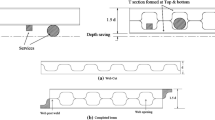Abstract
In steel I beams the corrugated webs are sometimes used as an alternative to plain web in many steel construction. The idea behind this concept is an increase in the shear capacity of steel beams without providing the transverse stiffeners. The recent development in steel construction is the used of web openings for the utilization of various technical utilities in web. This paper presents an extensive parametric study on the steel beam with corrugated web having openings in the web. The objective of the present study is to observe the structural performance of this special type of beam towards the strength capacities. In the parametric study 60 models of steel beams with trapezoidally corrugated web with opening has been analyzed by finite element analysis using ANSYS v12. The variables in the present study are angle of corrugation, thickness of web and diameter of opening. The angle of corrugation, web thickness and diameter of web openings considered in the study are 0°, 30°, 45° and 3 mm, 4 mm, 5 mm and 0.5, 0.6, 0.75 times the overall depth of beam, respectively. The parametric study shows that lesser the angle of web corrugation, the more increase in the load carrying capacity is obtained. Ultimate strength capacity of 30° corrugated web beam with different diameter of opening such as 0.5 D, 0.6 D, and 0.75 D is found to be 15.27%, 14.83%, 9.72%, which is more than the beam with plain web. The height to thickness (h/tw) ratio considered in the study are 30, 37.5, 40, 50, and 66.67, respectively. The height to thickness (h/tw) ratio is found to be the main parameter influencing the buckling behaviour of steel beam with corrugated web.



















Similar content being viewed by others
References
Abbas, H. H., Sause, R., & Driver, R. G. (2006). Behavior of corrugated web I-girders under in plane loading. Journal of Engineering Mechanics, 132(8), 806–814.
Chan, C. L., Khalid, Y. A., Sahari, B. B., & Hamouda, A. M. S. (2002). Finite element analysis of corrugated web beams under bending. Journal of Construction Steel Research, 58, 1391–1406.
Divahar, R., & Joanna, P. S. (2014). The effect of web corrugation in cold-formed steel beam with trapezoidally corrugated beam. American Journal of Engineering Research (AJER), 3(06), 137–142.
Divahar, R., & Joanna, P. S. (2018). Numerical simulation and experimental investigation on static behavior of cold formed steel beam with trapezoidally corrugated web by varying depth-thickness ratio. Asian Journal of Civil Engineering, 19, 121–137.
Elgaaly, M., Seshadri, A., & Hamilton, R. W. (1997). Bending strength of steel beams with corrugated webs. Journal of Structural Engineering, 123(6), 772–782.
Eurocode 3: Design of steel structures-EN 1993-1-5. (2006). Guideline for corrugated web beam. Brussels: CEN.
Kaveh, A., & Shokohi, F. (2014). Cost optimization of castellated beams using charged system search algorithm. Iranian Journal of Science and Technology, Transactions of Civil Engineering, 38(C1+), 235–249.
Kaveh, A., & Shokohi, F. (2015). Optimum design of castellated beams using colliding bodies optimization algorithm. Steel and Composite Structures, 2(18), 305–324.
Kaveh, A., & Shokohi, F. (2016a). Application of grey wolf optimizer in design of castellated beams. Asian Journal of Civil Engineering (BHRC), 17(5), 683–700.
Kaveh, A., & Shokohi, F. (2016b). Optimum design of laterally supported castellated beams using tug of war optimization algorithm. Structural Engineering and Mechanics, 3(58), 533–553.
Kovesdi, B., & Dunai, L. (2014). Fatigue life of girders with trapezoidally corrugated webs: An experimental study. International Journal of Fatigue, 64, 22–32.
Lindner, J. (1990). Lateral torsional buckling of beams with trapezoidally corrugated webs (pp. 305–310). Budapest: Colloquium on Stability of Steel Structures.
Morkhade, S. G., & Gupta, L. M. (2015). An experimental and parametric study of steel beams with web openings. International Journal of Advanced Structural Engineering, 7, 249–260.
Morkhade, S. G., & Gupta, L. M. (2017). Experimental investigation for failure analysis of steel beams with web openings. Steel and Composite Structures, 23(6), 647–656.
Morkhade, S. G., & Gupta, L. M. (2019). Ultimate load behaviour of steel beams with web openings. Australian Journal of Structural Engineering, 20(2), 124–133.
Morkhade, S. G., Kshirsagar, M., Dange, R., & Patil, A. (2019). Analytical study of effect of web opening on flexural behaviour of hybrid beams. Asian Journal Civil Engineering, 20, 537–547.
Morkhade, S. G., Shaikh, S., Kumbhar, A., Shaikh, A., & Tiwari, R. (2018). Comparative study of ultimate load for castellated and plain webbed beam. International Journal of Civil Engineering and Technology, 9(8), 1466–1476.
Nie, J. G., Zhu, L., Tao, M.-X., & Tang, L. (2013). Shear strength of trapezoidal corrugated steel webs. Journal of Construction Steel Research, 85, 105–115.
Romeijn, A., et al. (2009). Basic parametric study on corrugated web girders with cut outs. Journal of Construction Steel Research, 65, 395–407.
Sause, R., & Braxtan, T. N. (2011). Shear strength of trapezoidal corrugated steel webs. Journal of Construction Steel Research, 67, 223–236.
Wang, Z., & Wang, Q. (2014). Fatigue assessment of welds joining corrugated steel web to flange plates. Engineering Structures, 73, 1–12.
Zirakian, T., Hajsadeghi, M., Lim, J. B. P., & Bahrebar, M. (2016). Structural performance of corrugated web steel coupling beams. ICE Proceedings Structures and Buildings, 169(10), 756–764.
Author information
Authors and Affiliations
Corresponding author
Ethics declarations
Conflict of interest
On behalf of all authors, the corresponding author states that there is no conflict of interest.
Additional information
Publisher's Note
Springer Nature remains neutral with regard to jurisdictional claims in published maps and institutional affiliations.
Rights and permissions
About this article
Cite this article
Morkhade, S.G., Baswaraj, S.M. & Nayak, C.B. Comparative study of effect of web openings on the strength capacities of steel beam with trapezoidally corrugated web. Asian J Civ Eng 20, 1089–1099 (2019). https://doi.org/10.1007/s42107-019-00166-6
Received:
Accepted:
Published:
Issue Date:
DOI: https://doi.org/10.1007/s42107-019-00166-6




